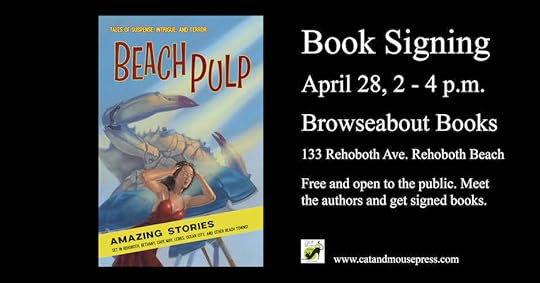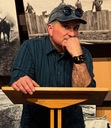Phil Giunta's Blog, page 33
May 4, 2019
May the Fourth Be With You!
Although saddened by the loss of Peter Mayhew earlier this week, I nevertheless wish you a Happy Star Wars Day!



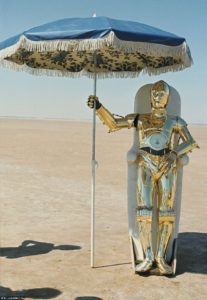

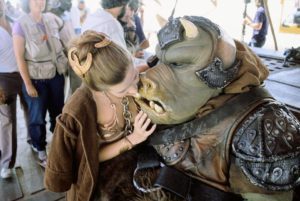


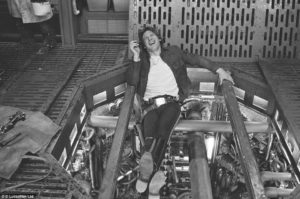
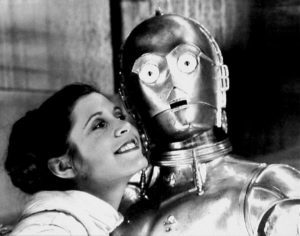

May 1, 2019
The Infinite Bard is On the Air!
As announced last week, THE INFINITE BARD is an international collection of authors joining forces to offer FREE fiction from epic adventure and spine-tingling action to thrills, chills, romance, humor, and mystery.
We begin with not one, not two, but three stories:
“Diamond of the Sky” by Azure Avians
“Blind Spot” by Donald J. Bingle
“First Command” by Chris A. Jackson
A brand new tale will follow every two weeks, so keep checking back. We hope you enjoy what you read. Please share the link and spread the word. We appreciate your support.
April 28, 2019
After-Action Report: Beach Pulp Book Signing
Another wonderful book signing has come to an end. I had a blast with my fellow Beach Pulp authors at Browseabout Books in Rehoboth Beach earlier today. Special thanks to Cat & Mouse Press owner and editor, Nancy Day Sakaduski, for publishing another fun anthology and for bringing us together at the beach!
From giant creatures to ghostly specters and from heroic superheroes to hard-boiled detectives, our beach towns are in for a shock. Beach Pulp is a collection of nineteen stories in the style of the old Amazing Stories pulp magazines set in Rehoboth, Bethany, Cape May, Lewes, Ocean City, and other beach towns that covers a range of genres, including science fiction, fantasy, horror, and noir.
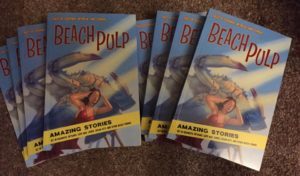 My Copies of Beach Pulp!
My Copies of Beach Pulp!
 Author Maria Masington at the Beach Pulp signing.
Author Maria Masington at the Beach Pulp signing.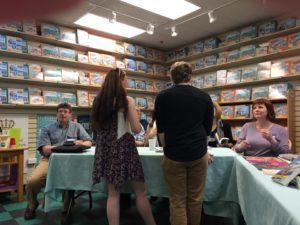 Beach Pulp contributors David Cooper (left) and D.M. Domosea (right) chatting with readers.
Beach Pulp contributors David Cooper (left) and D.M. Domosea (right) chatting with readers. David Cooper and James Gallahan signing copies of Beach Pulp for customers.
David Cooper and James Gallahan signing copies of Beach Pulp for customers. D.M. Domosea chats with Maria Masington while Steve Myers signs a copy of Beach Pulp.
D.M. Domosea chats with Maria Masington while Steve Myers signs a copy of Beach Pulp. D.M. Domosea and Linda Chambers (foreground). Steve Myers, Patrick Conlon (Beach Pulp associate editor), and Jacob Jones-Goldstein share the center table.
D.M. Domosea and Linda Chambers (foreground). Steve Myers, Patrick Conlon (Beach Pulp associate editor), and Jacob Jones-Goldstein share the center table.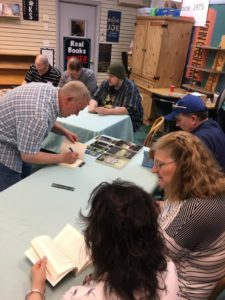 Jim Gallahan and I autograph each other’s copies of Beach Pulp while my tablemates, Chris Jacobsen and Maria Masington talk shop.
Jim Gallahan and I autograph each other’s copies of Beach Pulp while my tablemates, Chris Jacobsen and Maria Masington talk shop. Background to foreground: Beach Pulp contributors David Cooper, Jim Gallahan, Linda Chambers, Nancy Powichroski Sherman, D.M. Domosea, Steve Myers.
Background to foreground: Beach Pulp contributors David Cooper, Jim Gallahan, Linda Chambers, Nancy Powichroski Sherman, D.M. Domosea, Steve Myers.Prior to the book signing, my wife and I enjoyed walking the boardwalk and eating lunch at the Green Turtle. Overcast skies in the morning cleared by the afternoon and the welcome sunshine quickly raised the temperature to 73F. We look forward to returning for vacation this summer!
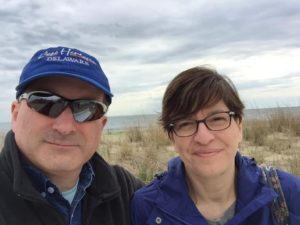
 The view from our table at the Green Turtle.
The view from our table at the Green Turtle. The view from our table at the Green Turtle.
The view from our table at the Green Turtle. The view from our table at the Green Turtle.
The view from our table at the Green Turtle.
April 24, 2019
The Infinite Bard
What is THE INFINITE BARD, you ask? It’s an international collection of authors joining forces to offer free fiction: epic adventure, spine-tingling action, thrills, chills, romance, humor, mystery.
THE INFINITE BARD launches on Wednesday, May 1 with three exciting stories. A brand new story will follow every two weeks. I was honored to be invited to participate.
Click here to visit the hub and see what’s new, then visit each author’s website to enjoy each new story as it’s released. Contributing authors include:
Rigel Ailur
Reid Alan
A. B. Alvarez
Lorraine Anderson
Dereck Attico
Azure Avians
Jess Barry
Ilsa Bick
Donald J. Bingle
Lauryn Christopher
Michele Dean
Leigh Dragoon
Felicia Fredlund
Dana Fredsti
Barbara G. Tarn
Phil Giunta
Jason Hardy
Chris A. Jackson
Tony Jones
Kris Katzen
Kari Kilgore
Michael Kingswood
Amy Laurens
Frazer Lee
Debbie Mumford
Mel Odom
Liz Pierce
Jean Rabe
Ben H. Rome
Aaron Rosenberg
Carolyn Rowland
Leigh Saunders
Bryan Thomas Schmidt
Wanda Shaner
Sarah Stegall
April 23, 2019
Book Signing at the Beach!
I have two stories in this marvelous anthology so I plan to be there. It’s been too long since I last saw the ocean and walked on the beach, both of which I hope to do before the book signing.
From giant creatures to ghostly specters and from heroic superheroes to hard-boiled detectives, our beach towns are in for a shock. A collection of nineteen stories in the style of the old Amazing Stories pulp magazines set in Rehoboth, Bethany, Cape May, Lewes, Ocean City, and other beach towns that covers a range of genres, including science fiction, fantasy, horror, and noir. There is even a graphic short story, told in twenty-four panels.
A Day at the Beach With the Gramthrottle Max Family by Weldon Burge
A Million Tiny Bites by D.M. Domosea
Call Again by Dennis Lawson
Hook, Line, and Sink Him by Maria Masington
I Fell for an Ice-Skating Alien by David Strauss
Missing in Rehoboth by James Gallahan
Moonwalker by David Cooper
Mystery of the Missing Girl Sleuth by Barbara Norton
Night Flyer by Chris Jacobsen
Operation Steamed by David Strauss
Rehoboth Beach in Crisis by Carl Frey
Sam Shade, Private Eye by Jackson Coppley
Smash Bronson by Steve Myers
Summer of the Gods by Jacob Jones Goldstein
Tapestry by Phil Giunta
The Celestials by Phil Giunta
The Dark Ride by Linda Chambers
The House that Wouldn’t be Sold by Nancy Sherman
When Worlds Collide by Patrick Conlon
Published by Cat & Mouse Press.
April 14, 2019
Book Review: The Caves of Steel by Isaac Asimov
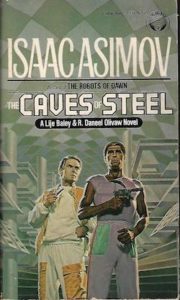 In the far future, humanity has long since colonized many worlds beyond our solar system with the help of positronic robots. During those years, an expanding philosophical and cultural schism has formed between the people of Earth and the “Spacers.” Colonists regard Earth—with its enclosed and overcrowded Cities, agoraphobic citizens, and abhorrence of robots—as a backward planet rife with filth, ignorance, and disease.
In the far future, humanity has long since colonized many worlds beyond our solar system with the help of positronic robots. During those years, an expanding philosophical and cultural schism has formed between the people of Earth and the “Spacers.” Colonists regard Earth—with its enclosed and overcrowded Cities, agoraphobic citizens, and abhorrence of robots—as a backward planet rife with filth, ignorance, and disease.
Just outside of New York City, Spacetown keeps its borders closed to citizens of Earth except by appointment and even then, visitors are required to shower and submit to a medical exam before being permitted to enter. After the murder of a prominent “Spacer” roboticist, Doctor Sarton, Spacetown authorities engage NYC police to investigate.
Enter plainclothesman Elijah “Lije” Bailey, assigned to the case by his agitated supervisor, Police Commissioner Julius Enderby, who seems more concerned about maintaining an amicable relationship with the Spacers than about solving the murder. More, Spacetown authorities insisted on assigning one of their own detectives to the investigation, Daneel Olivaw—a robot indistinguishable from a human, configured with a special “justice” circuit.
To make matters worse, members a subversive group called the Medievalists—whose goal is to see Earth return to a time reminiscent of the 20th century—somehow discover Olivaw’s true nature and begin conspiring against the two detectives, hampering their investigation.
Bailey is well aware that if the citizens of New York learn that an advanced humanoid robot walks among them, their paranoia and outrage could easily spark a destructive riot…
The Caves of Steel, referring to Earth’s enclosed cities, is the first in a trilogy of SF detective novels starring Elijah “Lije” Bailey and his android partner R. Daneel Olivaw (all robots in this trilogy are designated by the first initial of “R”). While the murder of Doctor Sarton is the catalyst that brings these two characters together, their investigation soon becomes secondary in favor of developing their partnership and to Olivaw’s full range of capabilities as a robot but lack of human cultural experience, as well as Bailey’s relationship with his wife, Jessie, and to a lesser extent, his son, Bentley.
Yet, Asimov adroitly ties all of these elements together for a neatly packaged and satisfying ending. There is little doubt as to why The Caves of Steel, and its two sequels (The Naked Sun and The Robots of Dawn) are counted among Asimov’s best works of science fiction. Asimov pays more attention to character development here than in many of his other novels, save perhaps for the Foundation series, in which Olivaw is also a fairly prominent character.
April 7, 2019
About This Writing Stuff…
Over at Career Authors, Hank Phillippi Ryan discusses cause and effect while Deanna Raybourn navigates the daunting ocean of social media. While we’re on the topic of the web, Anne R. Allen offers tips on crafting strong blog content. Need help writing an effective fight scene? Oren Ashkenazi has detailed advice for you.
All that and a little more… Enjoy!
How to Find Inspiration—Fiction Therapy by Jim Dempsey
When to Let Go of Your Original Inspiration by Kathryn Craft
How Do We Set Goals When Trying Something New? by Jami Gold
On the Joys of Indie Publishing by James Scott Bell
Scene Construction by John Gilstrap
Six Common Mistakes in Fight Scenes and How to Avoid Them by Oren Ashkenazi
First Things First: Does Your Manuscript Defy Physics? by Hank Phillippi Ryan
7 Tips for Social Media Savvy by Deanna Raybourn
How to Write for a Blog: 10 Tips for Writing Strong Web Content by Anne R. Allen
Editing for Authors: 7 Ways to Tighten the Story and Cut Costs by Kristen Lamb
‘Star Trek’/Dr. Seuss Mashup Deemed Copyright Fair Use by Judge by Eriq Gardner
Los Angeles Times Wants Rights to Books Written by Staff by The Authors Guild
April 1, 2019
No Foolin’, Folks… it’s Battle of the Books!
One week from today, I will be a participant in BATTLE OF THE BOOKS at the Whitehall Library in Whitehall, PA. Monday, April 8, 2019 at 6:30PM.
Organized by the Greater Lehigh Valley Writers Group, Battle of the Books is a friendly competition among three authors who read excerpts from their novels in such categories as Opening Lines, Setting a Scene, Compelling Dialogue, Action, Closing Lines, and Random Page (selected by the audience).
This will mark my third Battle of the Books as a competitor and my first time reading selections from my latest paranormal mystery novel, Like Mother, Like Daughters.
After each category, members of the audience vote for their favorite reading.
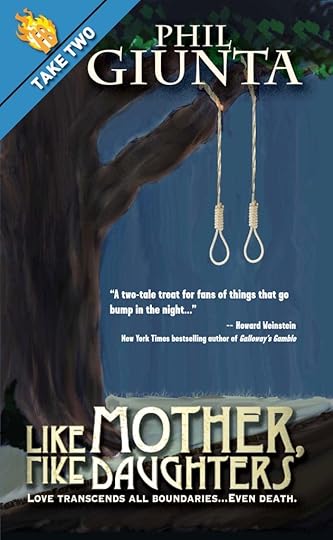
March 29, 2019
Book Review: Physics of the Impossible by Michio Kaku
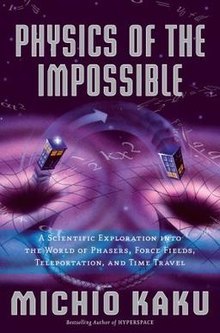 Co-founder of String Field Theory, Doctor Michio Kaku discusses the scientific plausibility of a wide range of popular science fiction devices, abilities, and technologies in his book, Physics of the Impossible.
Co-founder of String Field Theory, Doctor Michio Kaku discusses the scientific plausibility of a wide range of popular science fiction devices, abilities, and technologies in his book, Physics of the Impossible.
The topics covered in this engaging analysis include force fields, invisibility cloaks, phasers, laser beams, lightsabers, teleportation, telepathy, time travel, robots, psychokinesis, UFOs, alien races, faster than light travel, and more. Doctor Kaku references many popular SF TV shows and films including Star Trek, Star Wars, Flash Gordon, Back to the Future, Doctor Who, The Fly, Independence Day, E.T., and others.
I was delighted to note that Doctor Kaku also draws from a rich array of SF novels and short stories such as The Man Without a Body by Edward Page Mitchell, The Disintegration Machine by Sir Arthur Conan Doyle, Slan by A.E. van Vogt, Larry Niven’s Ringworld series, Isaac Asimov’s Foundation series, Douglas Adams’s Hitchhiker’s Guide to the Galaxy, and the works of Jules Verne, H.G. Wells, Arthur C. Clarke, and Robert Heinlein.
Backed by practical and theoretical physics, chemistry, biology, and a rich history of scientific discoveries, Doctor Kaku offers detailed explanations as to which fictional technologies and abilities might be possible in the future and which are simply impractical—at least based on our current understanding of science.
Physics of the Impossible is by far one of the most enthralling and illuminating scientific discourses I’ve read to date. I equate Doctor Kaku with Doctors Carl Sagan and Neil deGrasse Tyson for his considerable talents as a science communicator.
March 25, 2019
Book Review: Isaac Asimov’s Pebble in the Sky
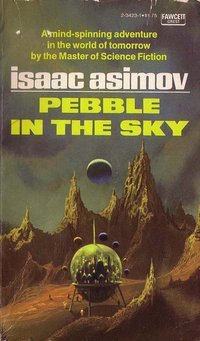 An accident at the Institute for Nuclear Research in Chicago releases a stray beam of radiation across the city, striking an innocent pedestrian by the name of Joseph Schwartz. No sooner does Schwartz step over a discarded rag doll on a busy street than he finds himself wandering for miles through dense woods.
An accident at the Institute for Nuclear Research in Chicago releases a stray beam of radiation across the city, striking an innocent pedestrian by the name of Joseph Schwartz. No sooner does Schwartz step over a discarded rag doll on a busy street than he finds himself wandering for miles through dense woods.
Schwartz eventually stumbles onto a highway that leads him to a remote farmhouse where he seeks help, yet the residents do not understand a word of his frantic pleas. Despite their trepidation that he might be an “outsider,” they take him in for the night.
The next day, one of the farmers escorts a frightened and despondent Schwartz into the city of Chica where he is experimented upon using a device called the Synapsifier, which allegedly accelerates the human brain’s ability to learn. The machine is the invention of seasoned neurosurgeon, Doctor Affret Shekt who is assisted in his work by his daughter, Pola.
Schwartz quickly escapes from the hospital and slowly begins to develop the ability to read minds. Along the way, he becomes a fluent speaker of the native language and realizes that, somehow, he was hurled far into Earth’s future on that disorienting day in Chicago—a future in which the planet is a second-class member of a Galactic Empire!
It isn’t long before Schwartz finds himself embroiled with the Shekts and a brash archaeologist named Bel Arvardan from Sirius who visits Earth in an attempt to prove his theory that the planet is the origin of the human race. Together, the four uncover a conspiracy to destroy all life on the other planets in the Empire—but can they convince the authorities before it’s too late?
Pebble in the Sky is an engaging read, but it struck me that the protagonist, which one presumes to be Schwartz, becomes lost for several chapters as the other characters, especially Bel Arvardan and Pola Shekt, take prominence. It isn’t until his psychic ability fully manifests that Schwartz once again becomes crucial to the plot.
Further, the main villain in the conspiracy against the other planets is not revealed until the final quarter of the story. Before this, the character appears only briefly. Despite these observations, Pebble in the Sky is notable for its tangential place in the Galactic Empire of Asimov’s Foundation series.



